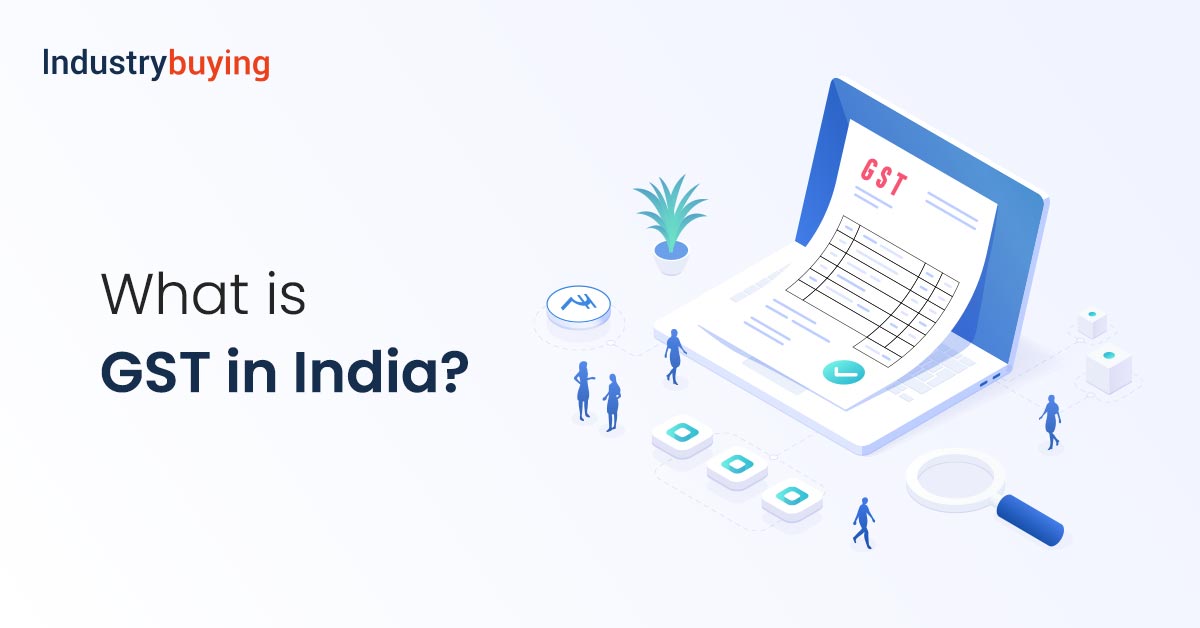What is GST in India? Definition, Types, Registration Process

Last Updated on December 6, 2024
GST, or Goods and Services Tax, was passed in the parliament on March 29, 2017, and enacted by the Government of India on July 1, 2017. GST was implemented with one main objective: to make India one unified common market. It is a multi-stage, destination-based tax imposed on the supply of goods and services from manufacturers to consumers.
Objectives of GST
The primary goals of implementing GST were:
- Simplification of Tax Structure: GST replaces complex indirect taxes with a single and unified tax.
- Avoidance of Double Taxation: It eliminates the different types of taxes levied at each supply stage, thereby removing the cascading effect, or ‘tax on tax.’
- Increased Compliance: Simplified processes for better tax compliance.
- Unified Market: Allow free flow of goods and services across state borders.
History of GST in India
| Date | Event |
| 2000 | GST was first proposed by the Atal Bihari Vajpayee government. |
| 2006 | Finance Minister P. Chidambaram set April 1, 2010, as the deadline for GST implementation. |
| 2011 | The Constitution Amendment Bill was introduced to enable GST; however, it faced significant challenges. |
| 2014 | The Narendra Modi government reintroduced the GST Bill in Parliament. |
| 2016 | The constitutional Amendment Bill on GST was passed in Parliament and approved by the president. |
| July 1, 2017 | GST was officially launched in India by PM Narendra Modi. |
Structure of Tax Laws before GST
Tax laws before GST were complex, with multiple taxes (Central Excise, Service Tax, and State VAT) levied at different stages. These taxes led to higher costs, inefficiencies and extra expenses for businesses. GST replaced these taxes and created a unified, simple structure, making compliance easier and more transparent.
Types of GST
There are four main types of GST in India that are collected by central and state governments. The types of GST are:
- Central Goods and Services Tax or CGST is levied by the central government and applies to intra-state transactions (transactions within the same state).
For example, If a good or service is sold within Uttar Pradesh, CGST and SGST are applicable and will be collected by the central government.
- State Goods and Services Tax or SGST is levied by the state government and applies to intra-state transactions (transactions within the same state).
For example, If a good or service is sold within Uttar Pradesh, CGST and SGST are applicable, and the state government will collect them.
- Integrated Goods and Services Tax or IGST is levied by the central government and applied to inter-state transactions (transactions between different states)
For example, If a good or service is sold from Uttar Pradesh to Maharashtra, IGST is applicable, and the central government will collect it.
- Union Territory Goods and Services Tax or UTGST is levied by the Union Territories and applied to UT transactions (transactions between Union Territories)
For example, If a good or service is sold within UT, UTGST & CGST is applicable and will be collected by the Union Territory.
Central and State Level Taxes Subsumed into GST
The following taxes have been subsumed under GST at the Central Level:
- Central Excise Duty
- Service Tax
- Additional Excise Duty
- Additional Custom Duty
- Special Additional Duty of Customs
The following taxes have been subsumed under GST at the State Level:
- State Value Added Tax/Sales Tax
- Entertainment Tax (exempting the tax imposed by the local bodies)
- Central Sales Tax (imposed by the Centre and collected by the States)
- Purchase Tax
- Luxury Tax
- Taxes on Lottery, Betting, and Gambling
- Octroi and Entry Tax
Taxes Exempted From GST
The following taxes have been exempted from GST:
- Basic Custom Duty
- Tax on Tobacco & Alcohol
- Tax on Petrol & Diesel
- Stamp Duty on Property
- Vehicle Tax
- Electricity Duty
- Property Tax
How Does GST Work?
GST is collected at each stage of production and distribution but is ultimately borne by the end consumer. Here’s a breakdown of how the GST system works in stages:
- Manufacturer: Buys raw materials, pays GST on purchase, and sells goods to the wholesaler, charging GST.
- Wholesaler: Buys goods, claims input tax credit (ITC) for GST paid on purchase, adds value, and sells to the retailer.
- Retailer: Purchases from a wholesaler, claims ITC on GST paid, and sells goods to consumers.
- Consumer: Bears the final GST burden with no ITC benefit.
By providing an Input Tax Credit (ITC) at each stage, GST eliminates the cascading effect of taxes, where tax is charged on tax. This makes the process fairer, more transparent, and less taxing on businesses.
GST Rates in India
GST rate is the percentage of tax levied on the sale of goods and services under GST acts. The GST rates in India are levied from lower-end products to luxury products. The GST rates are 5% (on essential items like packaged food), 12% & 18% (on essential items like computers & furniture), and 28% (on luxury items like cars and air conditioners).
For example, If you purchase a laptop worth ₹50,000, it is taxed at 18% GST:
- GST = (₹50,000 x 18%) = ₹9,000
- Final Price = ₹50,000 + ₹9,000 = ₹59,000
Goods and Services Under the 5% GST Slab
- Packaged food items (e.g., rice, wheat, pulses)
- Household necessities (e.g., sugar, coffee, tea)
- Transport services (e.g., railways, public buses)
Goods and Services Under the 12% GST Slab
- Packaged food items like frozen meat or canned vegetables
- Business equipment like printers and wallets
- Medicines and diagnostic kits
- Footwear priced above ₹1,000
Goods and Services Under the 18% GST Slab
- Electronics like laptops, monitors, and printers
- Furniture like tables, chairs, and wardrobes
- Industrial equipment like machinery and parts
- Restaurants (including those serving alcohol and room rates of ₹2000 – ₹2500 )
Goods and Services Under the 28% GST Slab
- Luxury items like air conditioners, refrigerators, and cars
- Entertainment services (e.g., cinema tickets above ₹100)
- Personal care items like premium shampoos and perfumes
- High-end consumer electronics like gaming consoles
New Compliances Under GST
Businesses are required to follow the new compliances under GST. These compliances are:
- E-Way Bills: These are used to track the transporting of goods.
- Input Tax Credit (ITC): Claiming credit for taxes paid on inputs.
- Regular Returns: Filing monthly, quarterly, and annual returns based on turnover.
Registration Process for GST
Businesses have to comply with GST laws and register for it. You can initiate your GST registration on the GST portal. After submitting the application, the portal will instantly generate an ARN (Application Reference Number) status. ARN will help you determine your application status. GST registration certificate and number are generally available within a week of ARN generation.
Who is Eligible for GST Registration and GST Number?
GST registration has several criteria and eligibility norms for a person or a company applying for a GST number. Companies registered successfully under GST get a unique GST number. The eligibility criteria are as follows:
Turnover of the Company:
- Businesses with a turnover exceeding ₹40 Lakh for goods and ₹20 Lakh for services must register for GST. (for some states, the turnover threshold is reduced to ₹10 Lakh for goods and services).
- Businesses below the threshold can also register for GST to avail of Input Tax Credit and grow credibility. However, for these businesses, GST registration is not mandatory.
Types of Businesses Required to Register
- Normal Taxpayer
- Composition Taxpayer
- Casual Taxable Person
- Input Service Distributors
- Non-Resident Taxable Person
- Non-Resident Online Services Provider
- E-Commerce Sellers
Other Requirements
- Businesses liable to pay tax under the reverse charge mechanism must register for GST.
- Individuals who sell items or services on behalf of another registered taxpayer must likewise register.
Documents Required for GST Registration
| Type of Business | List of Documents |
| Company (Indian/Foreign, Public/Private) | PAN of CompanyAddress Proof (Principal Place of Business) PAN & Aadhaar Card of Authorised Signatories PAN & Address Proof of Directors of the Company Article of Association or Memorandum of Association Proof of Appointing an Authorised Signatory Bank Details Photograph of Directors and the Authorised Signatory |
| Sole Proprietor or Individual | PAN Address Proof Aadhaar Card of Owner Bank Details Photograph of Owner |
| Hindu Undivided Family (HUF) | PAN (HUF) Address Proof Aadhaar Card & PAN card (Karta) Bank Details Photograph of Owner |
| Partnership Firms Inclusive of LLP | PAN Address Proof (Partners & Place of Business) Copy of Partnership Deed Registration Certificate or Board Resolution (for LLP) Photograph of Authorised Signatory and Partners Proof of Appointing an Authorised Signatory |
What is GST Registration Fees?
The government does not charge any fees for GST registration if you apply through the GST portal.
What is GST Number?
GSTIN is a 15-digit number unique to each taxpayer.
For example 27ABCDE1234F1Z5
- 27: State code (Maharashtra).
- ABCDE1234F: PAN of the business.
- 1: Entity number.
How to Calculate GST?
The formula to calculate GST is:
- GST Amount = (Original Cost x GST%)/100
- Total Price = Original Cost + GST Amount
For instance, if an item costs ₹1,000 and the GST rate is 18%, the GST amount would be ₹180, making the total price ₹1,180.
GST Return Filling
The registered businesses must complete the GST return monthly, quarterly, and annually.
Businesses must fill out these forms:
- GSTR-1: Sales report.
- GSTR-2: Purchase report.
- GSTR-3B: Monthly summary,
- GSTR-9: Annual return, filed yearly for complete yearly tax summaries.
Advantages of GST
- Simplified Compliance: A single tax reduces paperwork.
- Cost Savings: Eliminates double taxation and cascading tax effects.
- Unified Market: Enables seamless trade across state borders.
- Transparency: Digital records improve accountability, and a seamless tax regime enhances market efficiency.
For example, businesses no longer need to maintain separate records for Service Tax, VAT, and Excise, as GST replaces them all.
How has GST Helped in Price Reduction?
GST has helped in price reduction in the following ways:
- It eliminates the tax-on-tax structure.
- It allows businesses to claim input tax credits.
- It allows for streamlining the logistics and reducing supply chain inefficiencies.
For example, A manufacturer previously paid VAT on raw materials and Excise Duty on finished goods. Now, under GST, they only pay tax on the final value.
Industrybuying offers a 28% GST benefit discount on all its products at competitive prices. You can register to become a B2B customer and avail these benefits.
Conclusion
GST has been a game-changer for businesses and consumers, simplifying taxes, reducing costs, and fostering growth. GST has fundamentally changed how taxes are levied on goods and services in India. It has simplified the taxation system, reduced tax evasion, and boosted the nation’s economy. For businesses, understanding and complying with GST regulations is essential for smooth operations and sustainable growth.


